Sokcho
Sokcho (Korean: 속초; (Korean pronunciation: [sʰo̞k̚.tɕʰo̞])) is a city in Gangwon Province, South Korea. It is located in the far northeast of Gangwon. This city is a major tourist hub, and a popular gateway to nearby Seoraksan national park. Sokcho is home to the lakes Yeongrangho and Cheongchoho, that are naturally created by the East Sea.[1] It was under DPRK control from 1945 to 1950, but on August 18, 1951, the South Korean army captured it.[2][3]
Sokcho
속초시 | |
|---|---|
| Korean transcription(s) | |
| • Hangul | 속초시 |
| • Hanja | 束草市 |
| • Revised Romanization | Sokcho-si |
| • McCune-Reischauer | Sokch'o-si |
 Sokcho from the Lighthouse Observatory | |
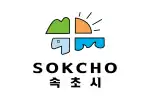 Flag  Emblem of Sokcho | |
 Location in South Korea | |
| Coordinates: 38°12′25″N 128°35′31″E | |
| Country | |
| Region | Gwandong |
| Administrative divisions | 10 dong |
| Area | |
| • Total | 105.25 km2 (40.64 sq mi) |
| Population (October 2022) | |
| • Total | 82,781 |
| • Density | 850/km2 (2,200/sq mi) |
| • Dialect | Gangwon |
| Climate | Cfa |

History
Sokcho originally was a part of Dongye roughly from the 3rd century to early 5th century BC. Sokcho started from just a fishing village with a few people around Cheongchoho. In 1905, it became one of the major ports because of its geological feature. Since Cheongchoho lake is adjacent to the East Sea, big ships were able to come in and out with ease. Later on, the city Sokcho, linked with Seoul by air and road, became a mineral transfer port in 1937. Upon the division of the Korean peninsula into two countries following World War II, Sokcho was on the North Korean side of the border, but since the Korean War armistice (1953), it has been a part of South Korea.[4][5]
Tourism
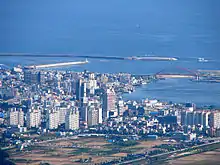
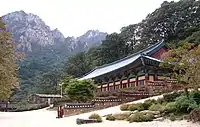
Seoraksan National Park is located in the vicinity of Sokcho and attracts many domestic and international tourists. The city itself is known for the beach, natural hot springs, and golf courses, as well as fine fishery products.
The nearby Yeongrangho lake is renowned for its beauty. The reflection of Seoraksan and its Ulsanbawi are particularly popular. There are a number of well-preserved Buddhist temples in the area around Sokcho. The main building of the Sinheungsa temple (Geukrakbojeon) is a major tourist destination (originally built in the 15th century). Also notable is the Hyangseongsaji samcheung seoktap, a three-storey pagoda of 4.3 metres. It dates from 652 and is located at the site of the Hyangseongsa temple.
Yeonggeumjeong, a pavilion built on the shores of Sokcho, is popular for its magnificent views of the sunrise, as well as for hearing the sound of the sea. It is thought that the pavilion was built at this location for sonic reasons.
Marina Yacht is located in Cheongchoho Lake Park and it provides a yacht tour on a wide expanse of the East Sea. The yacht sailing begins and ends at Cheongcho Marina passing Seorakdaegyo Bridge, Dongmyeonghang Port, Jodo in order. Marina Yacht rents boats to people who have a boat driving license. The place also operates a café.[6]
Yeongrangho Hwarangdo Experience Center is held various experience programs, horse riding members recruitment, and annual World Knight Championship. The center contributes to the transmission of traditional horseback martial art and popularization, and vitalization of horse riding.[7]
Abai village near Seoraksan was originally set up as an area to house North Korean refugees in Sokcho due to the separation of the two Koreas. Consequently, many of the population have relatives in North Korea. The village has seen increased tourism due to the popularity of the Korean Drama Autumn in My Heart on KBS.
In July 2016, Sokcho became one of the few locations in South Korea where Pokémon Go could be played due to government restrictions on mapping data. Players flocked to the city, causing bus tickets to sell out.[8][9]
In 1999, Gangwon International Tourism Expo was held.[10]
Today, a number of tourists are also attracted by the closeness to the DMZ.
Sokcho used to have its own airport, linking the city to Seoul. Currently, the city is served by the Yangyang International Airport.
The opening of KTX Kyung Kang line has made it convenient for travelers to visit Gangwon-Do province which is only an 86-minute train ride that starts from Seoul and tons of attractions.[11]
Daepo harbor is a port located in Daepo-dong, Sokcho. Mt. Seorak and the East Coast (of South Korea) turn into tourist attractions rather than national professional fishing port, Daepo harbor against tourists began to serve as destinations. Sokcho City offers various attractions such as sea fountain and beach cable car at Daepo harbor.[12][13]
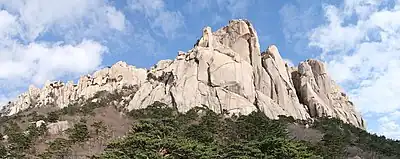 Ulsanbawi is a rock with 6 peaks
Ulsanbawi is a rock with 6 peaks Dong Myung Hang
Dong Myung Hang Dong Myung Hang
Dong Myung Hang Yeongrangho (Yeonglangho, Yeongnangho) Lake
Yeongrangho (Yeonglangho, Yeongnangho) Lake Cheongchoho Lake
Cheongchoho Lake Cheongcho Marina
Cheongcho Marina Cheongcho Marina
Cheongcho Marina KTX (Korea Train eXpress) Stay
KTX (Korea Train eXpress) Stay
Food
Sockho's traditional market is full of things to see, buy, and eat. Formed in 1953 as the Sokcho Tourist & Fishery Market, it was included on the Korea Tourism Organization's list of “Best Traditional Markets for Foreign Tourists” last year. With fresh fish caught off the coast in the East Sea to dried fish and various vegetables, one can have fun just looking around and watching the fishmongers bargaining with local market goers.[14][15]
Sokcho is known for Hoe, which is a raw fish. The coastal waters provide good fishing grounds for Ojingeo, Myeongtae, Gwangeo and Godeungeo.[16]
Sundubu can be found in the streets of the tofu towns such as Sinheung Sundubu and Haksapyeong Sundubu — it is made from Seoraksan and East Sea water.
Sokcho offers a unique twist to Sundae (not the eponymous dessert) by using Ojingeo instead of pork intestines. The Ojingeo-sundae consists of squid stir-fry, made with noodles and blood sausage, with carrots, onions, seaweed and spices mixed together, covered with thin fried egg yolk.[17]
 Ojingeo Sundae
Ojingeo Sundae Godeungeo Hoe
Godeungeo Hoe Gwangeo Hoe
Gwangeo Hoe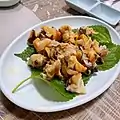 Jeon Bok Hoe
Jeon Bok Hoe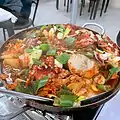 Mae Un Tang
Mae Un Tang Sundubu Jjigae
Sundubu Jjigae
Culture
Local cuisine can be experienced in the various food districts of the city. "Foodtown" is a two block area dedicated to restaurants where visitors can find mainly Korean style beef pork and chicken restaurants. Daepo harbor, outside of Sokcho on the road to Yangyang offers more than 100 individual mini restaurants serving diverse seafood dishes. An own unique stuffed squid dish, Abai Sundae, can be found in Abai village.
In October Sokcho comes to life with the Seorak Cultural Festival, which includes parades, stage shows, contests, races and various other forms of entertainment. The rice cake making sampling contests are particularly popular. Another unusual event is the Gaet-Bae, or raft, race. Two teams propel the rafts across the course by pulling on long handled hooks catching the cable that straddles the deck of each raft.
Climate
Sokcho straddles the line between a humid subtropical climate (Köppen: Cfa)[18] and a humid continental climate (Köppen: Dfa).[19]
| Climate data for Sokcho (1991–2020 normals, extremes 1968–present) | |||||||||||||
|---|---|---|---|---|---|---|---|---|---|---|---|---|---|
| Month | Jan | Feb | Mar | Apr | May | Jun | Jul | Aug | Sep | Oct | Nov | Dec | Year |
| Record high °C (°F) | 15.8 (60.4) |
19.1 (66.4) |
26.9 (80.4) |
32.5 (90.5) |
34.4 (93.9) |
35.3 (95.5) |
37.1 (98.8) |
38.7 (101.7) |
34.1 (93.4) |
29.9 (85.8) |
23.9 (75.0) |
17.8 (64.0) |
38.7 (101.7) |
| Average high °C (°F) | 4.2 (39.6) |
6.0 (42.8) |
10.6 (51.1) |
16.5 (61.7) |
20.9 (69.6) |
23.5 (74.3) |
26.7 (80.1) |
27.5 (81.5) |
24.0 (75.2) |
19.5 (67.1) |
13.1 (55.6) |
6.6 (43.9) |
16.6 (61.9) |
| Daily mean °C (°F) | 0.1 (32.2) |
1.9 (35.4) |
6.3 (43.3) |
11.9 (53.4) |
16.3 (61.3) |
19.8 (67.6) |
23.4 (74.1) |
24.1 (75.4) |
20.1 (68.2) |
15.1 (59.2) |
8.8 (47.8) |
2.5 (36.5) |
12.5 (54.5) |
| Average low °C (°F) | −3.8 (25.2) |
−2.2 (28.0) |
1.8 (35.2) |
7.3 (45.1) |
12.1 (53.8) |
16.5 (61.7) |
20.6 (69.1) |
21.2 (70.2) |
16.5 (61.7) |
10.8 (51.4) |
4.7 (40.5) |
−1.5 (29.3) |
8.7 (47.7) |
| Record low °C (°F) | −16.4 (2.5) |
−16.2 (2.8) |
−11.6 (11.1) |
−3.5 (25.7) |
3.8 (38.8) |
6.6 (43.9) |
12.6 (54.7) |
13.7 (56.7) |
9.5 (49.1) |
−0.3 (31.5) |
−8.7 (16.3) |
−14.9 (5.2) |
−16.4 (2.5) |
| Average precipitation mm (inches) | 43.5 (1.71) |
45.9 (1.81) |
52.3 (2.06) |
73.3 (2.89) |
88.5 (3.48) |
119.5 (4.70) |
265.6 (10.46) |
298.0 (11.73) |
200.6 (7.90) |
87.9 (3.46) |
92.0 (3.62) |
40.1 (1.58) |
1,407.2 (55.40) |
| Average precipitation days (≥ 0.1 mm) | 5.8 | 5.9 | 8.3 | 8.6 | 9.3 | 11.5 | 15.7 | 15.2 | 11.7 | 7.0 | 7.9 | 4.7 | 111.6 |
| Average snowy days | 5.0 | 5.1 | 4.1 | 0.2 | 0.0 | 0.0 | 0.0 | 0.0 | 0.0 | 0.0 | 0.7 | 2.2 | 17.3 |
| Average relative humidity (%) | 49.0 | 53.2 | 58.0 | 60.5 | 68.6 | 78.7 | 82.2 | 82.3 | 77.8 | 65.6 | 56.0 | 47.9 | 65.0 |
| Mean monthly sunshine hours | 185.4 | 176.9 | 194.9 | 211.9 | 216.3 | 172.4 | 146.3 | 152.4 | 166.8 | 189.8 | 169.0 | 184.3 | 2,166.4 |
| Percent possible sunshine | 60.0 | 56.4 | 51.4 | 53.7 | 48.9 | 36.8 | 30.6 | 35.9 | 44.2 | 54.2 | 55.4 | 61.4 | 47.8 |
| Source: Korea Meteorological Administration (snow and percent sunshine 1981–2010)[20][21][22] | |||||||||||||
Sister cities
 Jeongeup, North Jeolla since June 13, 1996
Jeongeup, North Jeolla since June 13, 1996 Jung-gu, Seoul since January 22, 1997
Jung-gu, Seoul since January 22, 1997 Gresham, Oregon, United States since June 23, 1985
Gresham, Oregon, United States since June 23, 1985 Taitung County, Taiwan since April 16, 1992
Taitung County, Taiwan since April 16, 1992 Hunchun, Jilin, People's Republic of China since August 22, 1994
Hunchun, Jilin, People's Republic of China since August 22, 1994 Yonago, Tottori, Japan since October 18, 1995
Yonago, Tottori, Japan since October 18, 1995 Khasansky, Primorsky Krai, Russia since July 19, 1996
Khasansky, Primorsky Krai, Russia since July 19, 1996 Nyūzen, Toyama, Japan since October 3, 1996
Nyūzen, Toyama, Japan since October 3, 1996 Sakaiminato, Tottori, Japan since April 9, 2002
Sakaiminato, Tottori, Japan since April 9, 2002 Partizansk, Primorsky Krai, Russia [23]
Partizansk, Primorsky Krai, Russia [23]
Gallery
 Sokcho south of Lake Cheongchoho
Sokcho south of Lake Cheongchoho Seorak Mountains adjacent to Sokcho
Seorak Mountains adjacent to Sokcho Squid drying at the Taepo Fish Market in Sokcho
Squid drying at the Taepo Fish Market in Sokcho Sinsuro Arched Bridge over Lake Cheongchoho in Sokcho
Sinsuro Arched Bridge over Lake Cheongchoho in Sokcho Squid boats on Lake Cheongchoho in Sokcho
Squid boats on Lake Cheongchoho in Sokcho Expo Tower in Sokcho
Expo Tower in Sokcho
Notable people from Sokcho
- Shin Ye-eun (Hangul: 신예은), a South Korean actress
- Park Kwang-su (Hangul: 박광수), a South Korean filmmaker
- Hwang Keum-chan (Hangul: 황금찬), a poet born in Sokcho, Gangwon-do
- Kim Kang-min (Hangul: 김강민), a South Korean actor under the label of Mystic Story
- Monday (birth name: Kim Ji-min, Hangul:김지민 ), singer, dancer, rapper and K-pop idol, member of K-pop girlgroup Weeekly
In literature
The novel Winter in Sokcho, by Elisa Shua Dusapin, which won the National Book Award for Translated Literature in 2021, takes place in Sokcho.[24]
References
- "Sokcho / Yangyang". Gangwon EPIK. Retrieved 3 December 2019.
- Cho, Young-mee Yu; Jung, Ji-Young; Ha, Jeeyoung Ahn (8 January 2021). Integrated Korean: Accelerated 2 (Page 234). University of Hawaii Press. p. 234. ISBN 978-0-8248-8951-7.
- Fern, Kelly; Fern, Brad (2012). Songs of My Families: A Thirty-seven Year Odyssey from Korea to America and Back. Lantern Books. ISBN 978-1-59056-321-2.
- "속초시", 위키백과, 우리 모두의 백과사전 (in Korean), 14 October 2019, retrieved 5 December 2019
- "Sokch'o | South Korea". Encyclopedia Britannica. Retrieved 5 December 2019.
- "Tourist Attractions - Marina Yacht 상세화면 | 강원관광-영문 > Trip to Gangwon-do > Tourist Attractions". www.gangwon.to. Retrieved 4 December 2019.
- "Main | 강원관광-영문 > Main". www.gangwon.to. Retrieved 4 December 2019.
- "South Koreans flock to remote northern area to play Pokémon Go". The Guardian. 13 July 2016.
- "Will 'Pokemon Go' launch in Korea?". Korea Herald. 13 July 2016.
- "7번 국도의 낭만이 살아있는 '속초' 가볼만한 곳과 맛집 - 트래블바이크뉴스". www.travelnbike.com (in Korean). 20 April 2018. Retrieved 7 June 2019.
- New KTX Gyeonggang Line opens, taking passengers from Seoul to Gangneung in less than 2 hours, retrieved 4 December 2019
- 박, 주석 (4 January 2021). "속초해변~대포항 연결 케이블카 조성 탄력". 강원도민일보 (in Korean). Retrieved 2 April 2021.
- 이, 종건 (9 July 2020). "대포항의 또 다른 볼거리…속초시 해상분수 시험가동". 연합뉴스 (in Korean). Retrieved 2 April 2021.
- "All about Sokcho". iamontheroad.net. 24 May 2015. Retrieved 1 July 2023.
- "Sokcho has a lot of local specialties sure to delight all travelers. | Official Korea Tourism Organization". english.visitkorea.or.kr. Retrieved 5 December 2019.
- "Korean Hweh, aka Raw Seafood". Eat Your Kimchi. 27 June 2013. Retrieved 4 December 2019.
- "Nasty Bits: Korean Blood Sausage". www.seriouseats.com. Retrieved 4 December 2019.
- Kottek, M.; J. Grieser; C. Beck; B. Rudolf; F. Rubel (2006). "World Map of the Köppen-Geiger climate classification updated" (PDF). Meteorol. Z. 15 (3): 259–263. Bibcode:2006MetZe..15..259K. doi:10.1127/0941-2948/2006/0130. Retrieved 8 December 2012.
- Peel, M. C.; Finlayson B. L. & McMahon, T. A. (2007). "Updated world map of the Köppen–Geiger climate classification" (PDF). Hydrol. Earth Syst. Sci. 11 (5): 1633–1644. Bibcode:2007HESS...11.1633P. doi:10.5194/hess-11-1633-2007. ISSN 1027-5606.
- "Climatological Normals of Korea (1991 ~ 2020)" (PDF) (in Korean). Korea Meteorological Administration. pp. II-9, II-10, II-439. Archived from the original (PDF) on 29 January 2022. Retrieved 31 January 2022.
- 순위값 - 구역별조회 (in Korean). Korea Meteorological Administration. Retrieved 5 October 2021.
- "Climatological Normals of Korea" (PDF). Korea Meteorological Administration. 2011. p. 499 and 649. Archived from the original (PDF) on 7 December 2016. Retrieved 7 December 2016.
- South Korean Investors Took a Fancy to Partizansk. It is planned to build an enterprise on production of charcoal in the city of miners - Economics - Vladivostok Times. Far East media news. Russian news. Vladivostok Archived 2011-07-16 at the Wayback Machine. Vladivostoktimes.ru. Retrieved on 2013-07-12.
- "National Book Awards 2021". National Book Foundation. Retrieved 17 November 2021.
